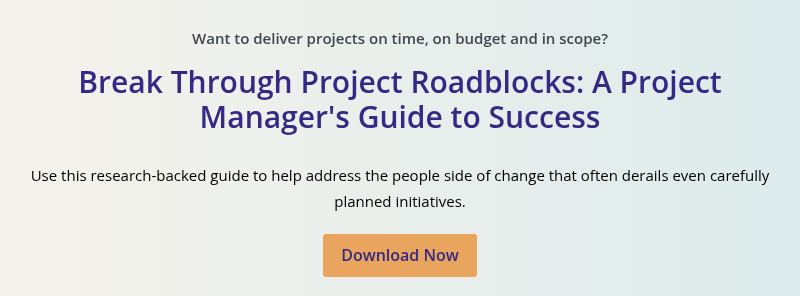Human Side of Digital Transformation in Financial Services

8 Mins
Updated: September 26, 2025
Published: June 17, 2025

Digital transformation in financial services is a powerful opportunity to modernize systems, improve customer experiences, and accelerate innovation.
But the real engine behind successful transformation?
People.
When teams understand, adopt and align with new ways of working, digital transformation moves from strategy to reality.
This guide will unpack why digital transformation matters, the common pitfalls financial institutions face, and how a structured change management approach can turn digital ambition into real, sustainable results.
What Is Digital Transformation in Financial Services?
Digital transformation in banking and the financial services sector involves using digital technologies to modernize how financial institutions operate, meet customer expectations and deliver value. It enables faster decision-making, improved customer experiences and more resilient operations across the organization.
Despite the focus on technology, people are at the center of any successful digital transformation.
As financial institutions evolve, they must rethink how professionals work together, how decisions are made, and how culture supports innovation. This means aligning leadership, employees and customers around new ways of working that keep up with changing expectations and evolving regulations.
Digital transformation is now a business imperative and an ongoing pursuit. Financial institutions that engage their people, strengthen their culture and build strong change capability are better positioned to meet future demands and lead the financial industry.
Why Digital Transformation Is Critical
Digital transformation supports long-term success across every area of the financial sector. When done right, it helps institutions operate more effectively and respond to market shifts with speed and confidence.
A successful digital transformation strategy enables financial services institutions to:
- Improve customer experience, engagement and customer satisfaction through personalized, on-demand digital services. Advanced technologies like mobile apps, AI-powered chat tools, online banking and digital self-service options provide seamless interactions.
- Increase operational efficiency by automating repetitive tasks and streamlining workflows. For example, loan processing, onboarding and document verification become faster and more consistent with robotic process automation.
- Enhance data-driven decision-making with real-time analytics and reporting tools. Financial professionals gain insight into customer behavior, risk exposure and emerging trends.
- Strengthen regulatory compliance by integrating systems that track, document and report activities. This supports audit readiness and reduces error rates.
- Drive digital innovation by modernizing legacy systems and enabling the launch of new digital products and services. Financial teams gain the flexibility to test and scale ideas quickly.
- Boost competitiveness against fintech disruptors and digital-native players. A well-executed transformation builds agility, supports growth and positions institutions as leaders in the digital economy.
Each of these outcomes depends on more than technology. The financial organizations that deliver long-term results from their digital transformations are the ones that aligned people, strategy and systems to create a strong foundation for change.
Examples of Successful Digital Transformation in Financial Services
The following real-world examples demonstrate how leading financial institutions used a people-centric change management approach to drive successful, sustainable digital transformation outcomes.
EisnerAmper: ERP implementation to support growth and acquisitions
Professional services firm EisnerAmper needed integrated systems to support organic growth and more than a dozen acquisitions, which their outdated legacy platforms couldn’t support. To enable continued expansion, they launched an enterprise-wide initiative to modernize operations by replacing what they described as “the nervous system of the organization.”
What it involved
The firm implemented SAP as its core ERP system, along with complementary platforms for CRM, timekeeping and expense tracking. A “big bang” switch-over moved the entire organization to the new system overnight.
Guided by Prosci’s structured, people-centric approach to change management, EisnerAmper built robust change capability using a hub-and-spoke model, with a central team and change champions across departments. Key activities included:
- Roadshows that reached 1,500 employees in 16 offices
- Development of role-specific communications and training
- Multi-channel learning using videos, job aids, live sessions and gamification
- Hands-on testing using real data, completed by nearly 200 users
Why it was successful
The project team embedded change management from the start, building structure, clarity and readiness into every phase of the rollout. They maintained engagement and momentum through:
- Effectively-trained leaders who remained visible and actively supportive of their teams
- Implemented feedback loops and a post-go-live support model that ensured the approach remained flexible and responsive
- Launched a branded internal campaign to create visibility and engagement across the organization
What they achieved
They completed the rollout on time and without disruption. KPIs, including logins, time entries, and invoices raised, confirmed strong adoption. EisnerAmper now has scalable systems and a Change Management Center of Excellence built on the Prosci Methodology to support future growth.

World Bank: Expanding digital capabilities through transformation management
As financial services became increasingly digital, the World Bank recognized the need to move faster, deliver more value and strengthen cybersecurity. Traditional project delivery models limited agility, while evolving digital risks placed data security as a top priority. The organization set out to accelerate transformation, improve digital literacy and enable secure innovation across a global workforce.
What it involved
The World Bank adopted agile methodologies to improve delivery speed and value focus within the banking sector. It expanded its digital capabilities through a wide range of initiatives, including:
- Introducing data analytics and digital tools across workflows
- Emphasizing continuous learning in areas like AI, machine learning and DevOps
- Rolling out a mandatory gamified cyber training program for 30,000 employees each year
- Deploying new tools to support digital adoption, including Microsoft Copilot and an internal AI platform for staff to access content with high data security
- Developing an AI framework with guiding principles, governance and roadmaps, and a “responsible use of AI” playbook
- Applying Prosci’s Proxima change management tool to monitor change strategies
- Nominating AI champions across functions to help scale knowledge and adoption
Why it was successful
The World Bank prioritized cultural change, inclusion and continuous learning. A comprehensive change management plan, grounded in Prosci’s change management methodology, helped teams navigate a complex transformation and support individuals through the transition.
The gamification of cyber training increased engagement, and a focus on outcomes rather than outputs helped to demonstrate tangible value. With a structured change approach, the World Bank built internal capability to lead change at scale.
What they achieved
Cyber errors among staff declined. The organization advanced its digital transformation initiatives while maintaining a strong security posture, creating an environment where responsible AI adoption can thrive.
These examples show what successful transformation looks like in practice. But without a structured approach that embeds change management into your digital transformation efforts, you’ll struggle to deliver lasting results.
Why Change Management Is Essential for Effective Digital Transformation
Digital transformation in banking and financial services brings both benefits and complexity. Success depends on people adopting new tools, shifting mindsets and sustaining outcomes. Change management provides the structure needed to move transformation forward—and make results stick.
Here are the key ways change management enables successful, sustainable digital transformation in banking and financial institutions.
Enhancing adoption and usage
Digital transformation initiatives introduce new business processes, technologies and workflows. Change management supports employees through the transition. It provides clear frameworks to communicate about what’s changing and why, hands-on training to build skills, and ongoing reinforcement to support new behaviors.
This helps people engage with the change and use new systems with confidence. It’s not surprising that organizations with strong change management are more likely to achieve project objectives, stay on schedule, and remain on or under budget.
Correlation Between Effective Change Management and Success
_digital%20transformation%20in%20financial%20services.webp?width=614&height=200&name=Correlation%20Between%20Effective%20Change%20Management%20and%20Success)_digital%20transformation%20in%20financial%20services.webp)
Aligning culture and strategy
Financial sector institutions often have established cultures that may resist change. Change management helps shift culture by engaging employees, clarifying expectations and reinforcing desired behaviors.
Structured communication, visible sponsorship and consistent messaging help connect daily work with organizational goals. This creates alignment between culture and digital strategy, making it easier to embed innovation and adaptability into the way people work.
Supporting people through change
Resistance to change is common in financial services, where employees are often accustomed to long-standing processes. Change management models like the Prosci ADKAR® Model provide a clear structure to support individuals through the change process.
The Prosci ADKAR Model

Sustaining outcomes
Digital transformation is an ongoing process. Change management practices help you sustain the benefits of digital initiatives by continuously supporting your employees and equipping them to adapt to evolving technologies and processes.
Improving project success
Change management increases the likelihood of digital transformation success by keeping stakeholders engaged and informed throughout the process. Targeted communication and role-specific training, customized to the needs of individuals and teams, reduces the risk of project delays and budget overruns.
Building change agility
Financial services institutions need to be agile and responsive to banking industry developments and market shifts. Structured change management fosters an agile mindset, helping teams quickly adapt to new technologies and changing demands as they emerge. This agility boosts competitive advantage.
Enhancing leadership and sponsorship
Robust change management focuses on effective leadership and sponsorship. A structured change management approach equips leaders to drive successful change by emphasizing clear communication, active leadership engagement, and tailored training and support.
Digital transformation offers opportunity but also risk. Financial institutions face operational, cultural and technical barriers that can stall progress if left unaddressed. Let’s explore common roadblocks on the path to digital transformation and how change management makes it easier to navigate them.

5 Common Challenges of Digital Transformation for Financial Companies (and How Change Management Helps)
Despite its many advantages, digital transformation introduces real challenges for financial institutions. Here are five common obstacles you may face in your digital transformation journey—and how to overcome them with effective change management.
1. Regulatory and compliance pressures
When adopting new digital tools and processes, financial services firms must navigate a complex web of regulations, such as KYC, AML, GDPR, and Dodd-Frank. Compliance missteps can delay transformation, trigger audits or damage trust.
How change management helps
Effective change management mitigates these risks by involving compliance teams from the start. Early engagement helps to identify and address regulatory requirements before new systems or processes go live.
Structured communication keeps impacted teams updated about regulatory impacts and individual responsibilities. Also, integrating key regulations into training supports employees in adopting new processes with clarity and accountability.
For example, when Microsoft Investor Relations needed to follow a complex 50-step process for their earnings release, they used the Prosci Methodology. This structured change management approach helped them navigate the process successfully with no errors.
2. Data security and trust concerns
Financial institutions manage sensitive data and high transaction volumes, making security a critical priority. New technologies or cloud platforms can raise concerns about data breaches, outages or unauthorized access, both inside the organization and with customers.
How change management helps
Change management builds trust by clearly communicating security measures and involving risk and cybersecurity teams at the early stages. It helps employees understand their role in protecting data by embedding safety protocols into training, adoption and day-to-day workflows.
With a structured change management approach, institutions can strengthen security awareness, reduce risk and maintain confidence while advancing their digital transformation goals.
3. Legacy systems and integration complexity
Many financial institutions still depend on aging core systems. Integrating modern digital platforms with these legacy environments adds complexity and increases the risk of operational disruption. Prosci’s Keys to Unlocking AI Adoption study reveals that 16% of AI adoption challenges stem from system integration issues. Without careful planning, even routine tasks can be affected during implementation.
How change management helps: Change management reduces integration problems by preparing employees for shifts in workflows and potential disruptions. It facilitates clear communication regarding timelines, system changes and integration milestones. Structured training equips employees with the capabilities needed to navigate digital transformation with confidence.
This proactive approach sustains productivity, reduces operational disruption, and enables a smoother integration of modern platforms with legacy systems, accelerating the path to value realization.
4. Customer adoption and experience risks
Launching digital tools like mobile apps, robo-advisors, or digital wallets introduces customers to new experiences. If those experiences are unclear or difficult to navigate, it may cause frustration and impact customer satisfaction.
How change management helps: A people-centric change management approach engages customer service teams early on, training them to guide customers through transitions effectively. It also supports continuous feedback loops that identify issues quickly so that they can be promptly addressed and continue to meet customer demand.
When employees are equipped to support customers through change, you can deliver cutting-edge digital experiences that maintain engagement and satisfaction.
5. Siloed organizational structures
Many financial institutions still work in silos, whether by function or geography. When you're going through a digital transformation, those boundaries can really hinder progress. If teams don’t share a clear understanding of the goals, roles and responsibilities, progress can become fragmented and slow down.
How change management helps: Structured communication, cross-functional engagement and shared accountability keep teams aligned and making progress, no matter where they are.
When people understand how their work connects to broader transformation goals and to each other, collaboration increases and organizations are better positioned to deliver change at scale.
Putting People at the Center of Digital Transformation in Financial Services
Digital transformation is redefining how financial institutions deliver services, manage risk and compete. New technologies bring potential, but progress depends on people. Real change can only happen when employees are engaged, equipped and supported throughout the transformation journey.
Change management provides the tools to lead that effort with purpose. Prosci partners with financial services teams to embed structured change capability, strengthen leadership alignment, and support transformation at every level.
With a people-first approach, you’ll be equipped to act faster, build resilience and create lasting impact.




